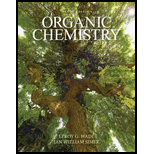
(a)
To determine: The products of the reactions with the given compound.
Interpretation: The products of the reactions with the given compounds are to be stated.
Concept introduction: The combination of chromic acid or excess sodium hypochlorite with acetic acid is used for the conversion of secondary alcohols into
The combination of
(b)
To determine: The products of the reactions with the given compound.
Interpretation: The products of the reactions with the given compounds are to be stated.
Concept introduction: The combination of chromic acid or excess sodium hypochlorite with acetic acid is used for the conversion of secondary alcohols into ketone and primary alcohols into carboxylic acid through oxidation reaction.
The combination of
(c)
To determine: The products of the reactions with the given compound.
Interpretation: The products of the reactions with the given compounds are to be stated.
Concept introduction: The combination of chromic acid or excess sodium hypochlorite with acetic acid is used for the conversion of secondary alcohols into ketone and primary alcohols into carboxylic acid through oxidation reaction.
The combination of
(d)
To determine: The products of the reactions with the given compound.
Interpretation: The products of the reactions with the given compounds are to be stated.
Concept introduction: The combination of chromic acid or excess sodium hypochlorite with acetic acid is used for the conversion of secondary alcohols into ketone and primary alcohols into carboxylic acid through oxidation reaction.
The combination of
(e)
To determine: The products of the reactions with the given compound.
Interpretation: The products of the reactions with the given compounds are to be stated.
Concept introduction: The combination of chromic acid or excess sodium hypochlorite with acetic acid is used for the conversion of secondary alcohols into ketone and primary alcohols into carboxylic acid through oxidation reaction.
The combination of
(f)
To determine: The products of the reactions with the given compound.
Interpretation: The products of the reactions with the given compounds are to be stated.
Concept introduction: The combination of chromic acid or excess sodium hypochlorite with acetic acid is used for the conversion of secondary alcohols into ketone and primary alcohols into carboxylic acid through oxidation reaction.
The combination of
(g)
To determine: The products of the reactions with the given compound.
Interpretation: The products of the reactions with the given compounds are to be stated.
Concept introduction: The combination of chromic acid or excess sodium hypochlorite with acetic acid is used for the conversion of secondary alcohols into ketone and primary alcohols into carboxylic acid through oxidation reaction.
The combination of
(h)
To determine: The products of the reactions with the given compound.
Interpretation: The products of the reactions with the given compounds are to be stated.
Concept introduction: The combination of chromic acid or excess sodium hypochlorite with acetic acid is used for the conversion of secondary alcohols into ketone and primary alcohols or aldehyde into carboxylic acid through oxidation reaction.
The combination of
Want to see the full answer?
Check out a sample textbook solution
Chapter 11 Solutions
Organic Chemistry (9th Edition)
- What is the product of the reaction? F3C. CF3 OMe NaOH / H₂Oarrow_forwardWhat would you expect to be the major product obtained from the following reaction? Please explain what is happening here. Provide a detailed explanation and a drawing showing how the reaction occurs. The correct answer to this question is V.arrow_forwardPlease answer the question for the reactions, thank youarrow_forward
- What is the product of the following reaction? Please include a detailed explanation of what is happening in this question. Include a drawing showing how the reagent is reacting with the catalyst to produce the correct product. The correct answer is IV.arrow_forwardPlease complete the reactions, thank youarrow_forwardConsider the synthesis. What is compound Y? Please explain what is happening in this question. Provide a detailed explanation and a drawing to show how the compound Y creates the product. The correct answer is D.arrow_forward
- What would be the major product of the following reaction? Please include a detailed explanation of what is happening in this question. Include steps and a drawing to show this reaction proceeds and how the final product is formed. The correct answer is B. I put answer D and I don't really understand what is going on in the question.arrow_forwardWhat is the product of the following reaction? Please explain what is happening in this question. Provide a detailed explanation and a drawing showing how the reagent is reacting with the catalysts to product the correct product. The correct answer is B.arrow_forwardWhat is the missing intermediate 1 and the final product 2. Please include a detailed explanation explaining the steps of malonic ester synthesis. Please include drawings of the intermediate and how it occurs and how the final product is former.arrow_forward
 ChemistryChemistryISBN:9781305957404Author:Steven S. Zumdahl, Susan A. Zumdahl, Donald J. DeCostePublisher:Cengage Learning
ChemistryChemistryISBN:9781305957404Author:Steven S. Zumdahl, Susan A. Zumdahl, Donald J. DeCostePublisher:Cengage Learning ChemistryChemistryISBN:9781259911156Author:Raymond Chang Dr., Jason Overby ProfessorPublisher:McGraw-Hill Education
ChemistryChemistryISBN:9781259911156Author:Raymond Chang Dr., Jason Overby ProfessorPublisher:McGraw-Hill Education Principles of Instrumental AnalysisChemistryISBN:9781305577213Author:Douglas A. Skoog, F. James Holler, Stanley R. CrouchPublisher:Cengage Learning
Principles of Instrumental AnalysisChemistryISBN:9781305577213Author:Douglas A. Skoog, F. James Holler, Stanley R. CrouchPublisher:Cengage Learning Organic ChemistryChemistryISBN:9780078021558Author:Janice Gorzynski Smith Dr.Publisher:McGraw-Hill Education
Organic ChemistryChemistryISBN:9780078021558Author:Janice Gorzynski Smith Dr.Publisher:McGraw-Hill Education Chemistry: Principles and ReactionsChemistryISBN:9781305079373Author:William L. Masterton, Cecile N. HurleyPublisher:Cengage Learning
Chemistry: Principles and ReactionsChemistryISBN:9781305079373Author:William L. Masterton, Cecile N. HurleyPublisher:Cengage Learning Elementary Principles of Chemical Processes, Bind...ChemistryISBN:9781118431221Author:Richard M. Felder, Ronald W. Rousseau, Lisa G. BullardPublisher:WILEY
Elementary Principles of Chemical Processes, Bind...ChemistryISBN:9781118431221Author:Richard M. Felder, Ronald W. Rousseau, Lisa G. BullardPublisher:WILEY





